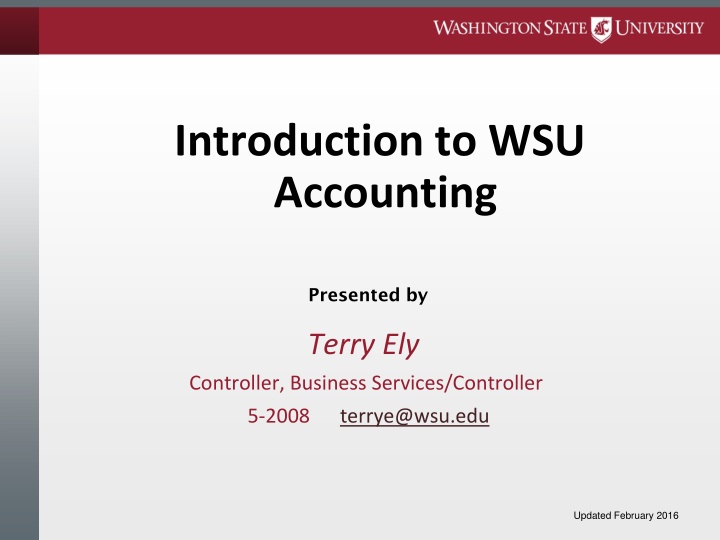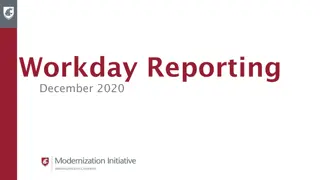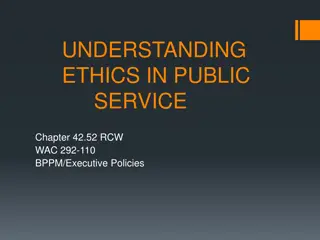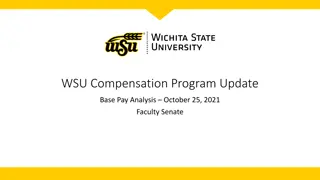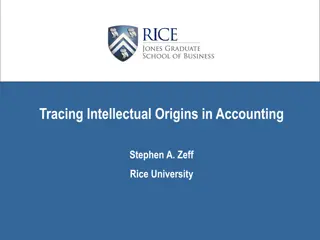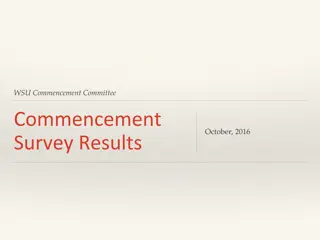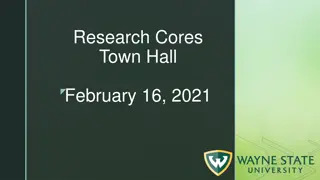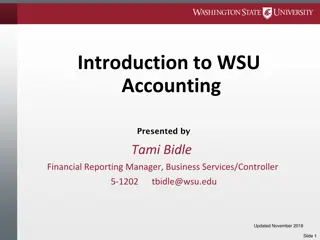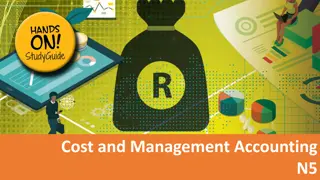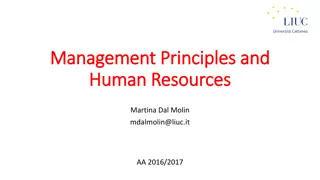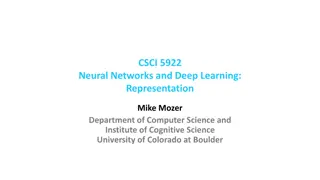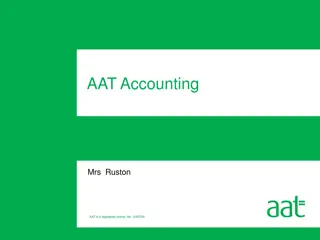Introduction to WSU Accounting
Washington State University's accounting framework and systems are explored in this informative presentation by Terry Ely, Controller of Business Services. Gain insights into WSU's history, training classes available, and resources for questions. Learn about WSU's unique position as a public research institution and its vision for the future. Explore how WSU operates as an agency of the State of Washington, focusing on education as a business enterprise. Discover the competitive nature of WSU as it strives to attract students and excel in research.
Download Presentation

Please find below an Image/Link to download the presentation.
The content on the website is provided AS IS for your information and personal use only. It may not be sold, licensed, or shared on other websites without obtaining consent from the author.If you encounter any issues during the download, it is possible that the publisher has removed the file from their server.
You are allowed to download the files provided on this website for personal or commercial use, subject to the condition that they are used lawfully. All files are the property of their respective owners.
The content on the website is provided AS IS for your information and personal use only. It may not be sold, licensed, or shared on other websites without obtaining consent from the author.
E N D
Presentation Transcript
Introduction to WSU Accounting Presented by Terry Ely Controller, Business Services/Controller 5-2008 terrye@wsu.edu Updated February 2016
Objectives Some history of WSU WSU s basic accounting framework, its systems and how they inter-relate List the training classes that you can take to learn more about each of these systems List the resources and people that you can go to when you have a question Please Ask Questions! Slide 2
Tell me a little about you Where do you work? What do you hope to learn from this class? Slide 3
Washington State University is Washington State s Land Grant University Morrill Acts of 1862 and 1890 Hatch Act of 1887 Smith-Lever Act of 1914 Slide 4
WSU is a public research university committed to its land-grant heritage and tradition of service to society. WSU has a long tradition of excellence. It has great plans for the future. If you d like to share that vision, see the university s mission statement and Strategic plan at the website below. In addition, Finance and Administration has a vision and mission statement as well. We are in the process of updating it now. https://strategicplan.wsu.edu/ http://baf.wsu.edu/StrategicPlan.html Slide# 5
WSU is also an agency of the State of Washington, but . A different kind of agency WSU doesn t collect taxes like the Department of Revenue WSU doesn t build roads like the Department of Transportation WSU sells education to students We operate more like a business enterprise. CougarHead.gif Slide# 6
A competitive state agency Must compete to attract students Must compete to attract research Result very different expenses Sometimes our unique requirements make trying to fit into the state s mold uncomfortable. But it can be done. Slide 7
A picture is worth 1,000 words Slide 8
WSUs Business Policies and Procedures have their basis in the state s laws and policies. Washington State Constitution http://www.leg.wa.gov/lawsandagencyrules/pages/constitution.aspx Revised Code of Washington (RCWs) http://apps.leg.wa.gov/rcw/ Washington Administrative Code (WACs) http://apps.leg.wa.gov/wac/ WSU Business Policies and Procedures http://www.wsu.edu/~forms/manuals.html Office of Financial Management (OFM) State Administrative and Accounting Manual http://www.ofm.wa.gov/policy/default.asp Slide# 9
Why do we have all these rules? These laws and regulations provide the guidance framework for how the State does business. When properly implemented and followed, they will safeguard our resources, protect our staff, and provide internal controls to ensure that we are careful stewards of our public funds. These rules also guide us in how we track all of the business we ve done. They define what our accounting systems need to track, how to record transactions to properly account for the financial resources we ve received or used. Slide 10
FUND ACCOUNTING Governments use fund accounting. Fund accounting was created to enable governments to be accountable to their citizens. Tax levies for a specific project are placed in a specific fund for that project. Expenditures made to accomplish that project come out of that same fund. At the end of the project, citizens can see that their money was used as they had intended. Slide 11
But wait! Theres more! Governmental Accounting Standards Board (GASB) Establishes the requirements for financial statement presentation and footnote disclosures for governments and public universities Currently they have issued 64 pronouncements National Association of College and University Business Officers (NACUBO) Provides detailed guidance to public and private colleges and universities on how to implement the guidance provided by GASB (and FASB) These rules apply to how we must account for transactions within our accounting systems. Slide 12
Brief History of College and University Accounting NACUBO FASB GASB Blank Slate Project Slide 13
University Accounting WSU uses fund accounting ( bucket accounting ) The source of the funds determines the bucket it goes into. State appropriated funds Self-sustaining funds Grant funds Donated funds Slide 14
UNRESTRICTED or RESTRICTED Unrestricted funds can be expended for any lawful purpose Restricted funds can only be used for a specific purpose established by an outside person or entity Slide 15
The Color of Money State appropriation funded budget Operating account 06F-5555-0001 Instruction & departmental research for The College of Business PBL funded Slide 16
The Color of Money, continued Federally sponsored grant money Grant account 11E-5555-0002 Federal grant from the Department of Commerce to design a better mousetrap Slide 17
Your Dean wants to Support the Grant Transfer money from our state account into the grant account so they can buy more cheese. You send an email to General Accounting requesting them to transfer the funds. They will tell you that you can t do that. Why?
The Color of Money, continued Green money is unaccountable When you move yellow money and put it into blue money , it becomes muddied green money . You can no longer tell what the grant money was spent for and what the PBL money was used for. To account for both types of money correctly, you should by the cheese with the PBL money and then let the grant use it. You can show the cheese purchase as cost share on the grant. Some mixing of funds is allowable. In general, if you want to move money from one account to another within the same fund, you can do that. If you want to move money from one fund to a different fund, call the Controller s office first. Slide 19
What Color is My Money? You can tell by the fund number Unrestricted operating funds are: 001, 148, and 149 Unrestricted internal service & auxiliary funds are: 400 s & 500 s Restricted grant funds are: 143 & 145 Restricted donated funds are: 846 Slide 20
Donated Funds Not considered state money Fewer restrictions on spending than state money Can t move state funds into donated funds Please read our 17A policy BPPM 70.33 Slide 21
How do I know what my money is to be used for? You can tell by the program and subprogram Instruction & Departmental Research (Programs 06 & 10) Sponsored Research (Programs 11, 12, 13, & 14) Public Service (Program 09) Student Services (Program 03) Academic Support (Programs 07 & 08) Institutional Support (Program 01) Operation & Maintenance of Plant (Program 04) Auxiliary Enterprises (Program 15) Scholarships, Financial Aid, Donations (Program 17) Slide 22
Who can I call if I have a question about how to account for the money in my buckets? Terry Ely, 5-2008 terrye@wsu.edu Joy Morton, 5-2072 joy.morton@wsu.edu Robert Wright, 5-2024 wrightrd@wsu.edu Tami Bidle, 5-1202 tbidle@wsu.edu Slide 23
How do Funds and Programs fit into WSUs Financial Reporting? Revenues are summarized by source Expenditures are summarized by object and by program Required adjustments, accruals, and reclassifications are made The result becomes the income statement on our financial statements WSU financial statements are available online at: http://www.wsu.edu/genacct/finstat.htm Slide 24
Chart of Accounts An organization s chart of accounts forms the structural framework for accounting for all the organization s financial transactions. Funds Programs Revenues Expenditures Other
General Ledger and Budgetary Sub-ledger FACTS BALANCES
BALANCES Cash basis Revenues, Allocations, Encumbrances Expenses Cash
FACTS Balances transactions feed to it through two control accounts, 7101 for revenue and 8101 for expenses Offset is cash, 1103 Facts records all balance sheet transactions and converts our accounting system to an accrual basis
A Quick Walk through the Chart Funds Programs Revenue Sources Expenditure Objects
Funds Follows the State s accounting system All WSU transactions are summarized and transmitted to the State monthly State Operating Appropriations 001 (Unrestricted) State Capital Appropriations 057 and 062 (Restricted) 057 are monies provided by State budget for capital projects 062 are monies earned on the land grant endowments and can only be spent for capital projects and debt service Federal Operating Appropriations 143 (Restricted) Grants and Contracts 145 (Restricted)
Funds, continued Self-sustaining Funds 148 (Unrestricted) Some are allocated 148-02 F&A Cost Recovery 148-05 Admin Fees and Interest Others are managed by departments These generate revenue Their functions are education-related They are set up as service centers They are supposed to operate on a break-even basis
Funds, continued Tuition and Fees - 149 (Unrestricted) All tuition revenue is deposited to these funds. The tuition revenue is then combined with the State operation appropriations and allocated to departments as part of their 001 allocation.
Funds, continued Local Construction Funds 252 (Sorta restricted) These funds are used to track construction projects that will be paid for with university funds or bond proceeds Internal Service Funds 4XX (Unrestricted) These funds are used by departments that perform services for all units of the university. Examples are: Central Stores, Motor Pool, Printing & Publications, and Facilities.
Funds, continued Auxiliary Funds 5XX (Unrestricted) These are fully self-supporting business-type operations that provide services to customers of the university students Examples are: ASWSU, the CUB, the Student Recreation Center, and Housing and Dining. Donated Funds 846 (Restricted) These funds contain monies donated to the university through the WSU Foundation. The monies may be used only for the purpose established by the donor.
Funds, continued Loan Funds 849 & 860 (Restricted) These funds track the various types of loans the university is authorized to issue to students. Endowment Funds 859 (Permanently Restricted) The WSU Foundation holds most of the university endowments, but WSU does hold a few on our books. Agency Funds These are used for tracking money that WSU holds for others. Examples are: student clubs.
Revenue Source Codes Source and sub-source codes are used to identify the type of revenue received. Revenue cannot be recorded in all types of funds. In general, self-sustaining, internal service, auxiliary, grant, and agency funds can receive revenue. Before generating revenue, the department needs to submit a request to create a service center.
Classifications of Source Codes 0300 Federal Revenue These are generally only used by grant funds 0400 Miscellaneous These record revenue from property rentals, endowments, investment income, and sale of property and equipment 0420 Charges for Services The codes are meant to track revenues for charges to other departments of the university.
Classification of Source Codes, continued 0424 Tuition and Fees These codes are used to classify the types of tuition and fees charged to students. 0424-9x and 0425-xx record tuition waivers 0428 Revenue from Sales within an Area When a department sells something to another department within their area, these source codes are used. Using these codes tells accounting why there was no administrative service charge applied.
Classification of Source Codes, continued 0430 Dedicated Student Fees These codes are used to classify course fees and other student fees. 0440 F&A Cost Recovery These codes are used by Sponsored Programs to record the F&A revenue received from grants. 0451 Revenue from Sales to Students and Outside Customers These codes are used to classify sales made to customers of the university students or other universities, or outside businesses.
Classifications of Source Codes, continued 0473 Investment Costs 0541 Contributions These codes are used by the WSU Foundation to record contributions received 0546 Federal Pass-Thru Revenue These codes are used by Sponsored Programs to track Federal revenues received through non- Federal entities 06xx Transfers (Revenue transfers)
Objects of Expenditure 00 Salaries 01 Wages 02 Service Contracts Personal or Purchased 03 Goods and Supplies 04 Travel 06 Capitalizable Equipment 07 Employee Benefits 08 Scholarships 09 Principal and Interest on Debt 10 Capitalizable Land or Buildings
Objects of Expenditure 12 Depreciation, Amortization, Bad Debt Expense 13 F&A Charged to Grants (Sponsored Programs only) 14 Sub-Contract Expenses (Sponsored Programs only) 15 Cost of Goods Sold (only used by H&D) 16 Non-Capitalized Equipment 2x Intra-agency Reimbursements
WSU Accounting Systems AIS PAPR purchasing & accounts payable AIS DEPPS payroll & position control SIS student & general accounts receivable AIS SCBAIMS service center billing AIS BPS budget system/PBL data Slide 43
Other Systems Purchasing Card/Central Travel Point of Sale cashiering Property Inventory Facilities, Land Cost Share/Effort Reporting WSU Org Endowment Investment Tracking Slide 44
AIS Balances Allows you to view your accounts in summary and detail Flexibility Multiple years Essential tool Refer to BPPM 85.33 to request access Sign up for AIS: Account Balances training through HRS Slide 45
Financial Data Warehouse Almost all data that goes into AIS Balances is exported to the financial data warehouse. Using Business Objects as the query tool, you can write and run reports to gather all information about your budgets The license is now free to all who need access. https://infotech.wsu.edu/DataWarehouse/FinancialData/AccessProcedure.aspx Slide 46
AIS HEPPS/DEPPS Payroll processing system This system contains information on employees, payroll and position control Training is available through Human Resources http://www.hrs.wsu.edu/Fiscal%20Management%20Training%20R esource%20Materials Payroll data is fed to the Financial data warehouse Slide 47
DEPTPAY All departments must have two people who have been trained in inputting hours for hourly staff and reviewing gross pay for departmental employees. You must attend training before you can use DEPTPAY. You must have access to DEPPS before you can get training. The training is offered through Human Resources. Slide 48
PERMS & TEMPS Personnel Action Forms must be completed using the PERMS system Frequently asked questions about PERMS http://www.hrs.wsu.edu/utils/File.aspx?fileid=5158 You may access PERMS via the following websites: https://webapps.wsu.edu/ais/perms/permsmaster/permswelcome.aspx Temporary Employee Personnel Actions must be processed using the TEMPS system TEMPS Training Manual http://www.hrs.wsu.edu/utils/file.aspx?fileid=1007 BPPM 60.26 Both PERMS and TEMPS training is available through Human Resources http://www.hrs.ws.edu/ILT%20Schedule.htm Slide 49
Fiscal Management Training Human Resources offers a comprehensive selection of classes that will give you the knowledge you need to do your job well. Some of the classes are online, others are instructor-led like this one. See what is offered and the class schedules at: http://www.hrs.wsu.edu/Fiscal+Management+Training+Resource+Materi als Slide 50
